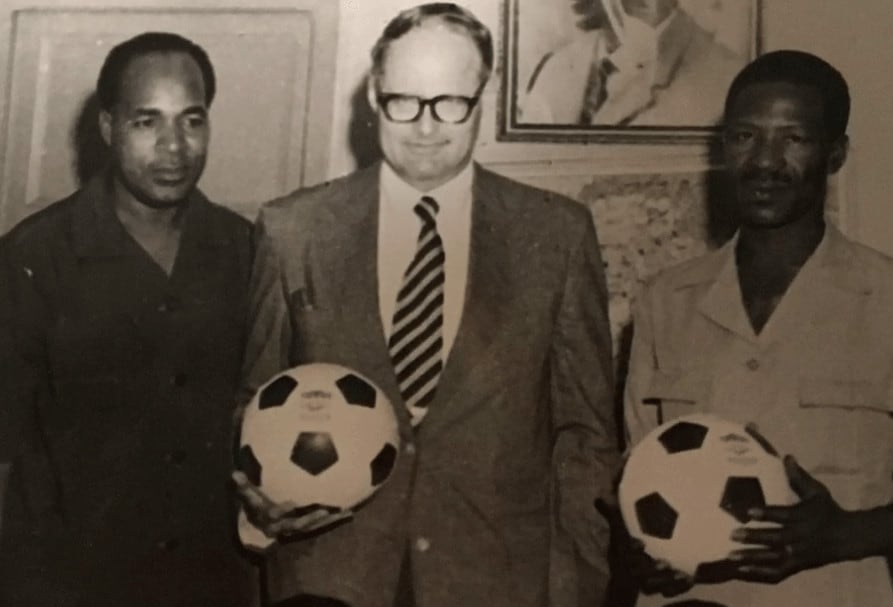Ever since the Kennedy administration, the United States has increasingly felt a sense of responsibility for people in Africa. As a result, the United States has had numerous Peace Corps missions and USAID projects spread throughout the continent. In Guinea,

however, by 1975 the Peace Corps had been in and out of the small country twice, and the United States had virtually no aid projects on the ground.
When career Foreign Service Officer William C. “Bill” Harrop arrived in Africa to take up his duties as ambassador, Guinea was going through a rough patch. President Sékou Touré, leader of the radical pan-Africanist movement, had been in office for over twelve years. Guinea, a country that had been relatively prosperous, was stricken by poverty as a result of Touré’s socialist leadership. While the Soviets and the Chinese operated from a strong position, by comparison the United States had a relatively modest presence in the small nation.
Harrop tried to get a USAID project going, but three years of hard work brought forth little success. He and his team hit lots of hurdles along the way, both bureaucratically and politically. So what actions could he undertake to build goodwill towards the United States in Guinea? Harrop decided to use a $25,000 discretionary fund to buy soccer balls and spread those around the country. As a result, kids who had been kicking around plastic bags and balloons now played with proper soccer balls. More importantly, Harrop’s gesture allowed the kids to connect their love of soccer to the United States. The project, which initially brought some criticism from officials in Washington, ultimately proved to be a success. To this day, Bill Harrop thinks this was one of his best ideas while in the Foreign Service.
Apart from his ambassadorship in Guinea, William Harrop also held positions in Italy, Belgium, Australia, Kenya, Zaire, and Israel.
William C. Harrop’s interview was conducted by Charles Stuart Kennedy on August 24, 1993.
Read William C. Harrop’s full oral history HERE.
Watch the video on this exceptional story HERE or listen to the podcast HERE.
Drafted by Ianthe Van Dyck
ADST relies on the generous support of our members and readers like you. Please support our efforts to continue capturing, preserving, and sharing the experiences of America’s diplomats.
Excerpts:“I said to myself, ‘Why don’t we give these people some good soccer balls?’ So, I bought $25,000 worth of American soccer balls.”

How to spend $25,000?:
HARROP: While I was ambassador to Guinea, between 1975 and 1977, I took advantage of a program that was then operating—and it was really quite a good idea at the time—through USAID’s (United States Agency for International Development) good offices. Every American ambassador had access to $25,000, which he could use as he thought best for American interests, for goodwill, and for obtaining our political objectives in his country. I kind of puzzled on how to use this.
Guinea was a country that was really in terrible poverty. It should not have been. As a French colony it was one of the most prosperous. It has excellent rainfall; excellent arable land; a good climate. Unfortunately, however, the president, Sékou Touré, was the great African socialist. His was the only country among the dozen or so of the French colonies in Africa who refused to join the French Union and retain their links to France after their independence. In 1958, he took Guinea into independence of its own, and the country then really went downhill fast. The poor people were just impoverished. The collective farming was not successful; there was hunger. Really, it was a very sad country during the time we were there—and for many years before and after that, as a matter of fact.
Kicking Balloons, Bags, or Rags:
I had the $25,000, and wondered, “Now, what can I do?” African boys—little children and big children around in the villages and the towns—would play about on football fields, or just on fields, kicking balloons, bags, or rags that they tied up as footballs; but they had no footballs! I said to myself, “Why don’t we give these people some good soccer balls?” So, I bought $25,000 worth of American soccer balls. Each one had the famous USAID “hand clasp” on it as a gift from the American people. Then, we handed these out over the whole country.
Love of Soccer:
I think President Sékou Touré was a little embarrassed because they were so popular and that he’d not been able to provide footballs for his people. But it was a huge hit. I don’t know how many hundred balls I was able to provide to them, but it was very much appreciated. Although there was a lot of criticism and carping back in Washington that this was not a serious American development effort. However, I think that was wrong. I think it was one of my best ideas in the Foreign Service to let the youth of Guinea kind of relate their love of soccer to the United States of America.
TABLE OF CONTENTS HIGHLIGHTS
Education
BA in English Literature, Harvard University
MA in Journalism, University of Missouri
Joined the Foreign Service 1954
Conakry, Guinea—Ambassador 1975–1977
Nairobi, Kenya—Ambassador 1980–1983
Kinshasa, Zaire—Ambassador 1988–1991
Jerusalem, Israel—Ambassador 1992–1993
